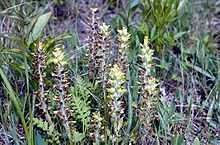Pedicularis canadensis
| Pedicularis canadensis | |
|---|---|
 | |
| Scientific classification | |
| Kingdom: | Plantae |
| (unranked): | Angiosperms |
| (unranked): | Eudicots |
| (unranked): | Asterids |
| Order: | Lamiales |
| Family: | Orobanchaceae |
| Genus: | Pedicularis |
| Species: | P. canadensis |
| Binomial name | |
| Pedicularis canadensis Hadač | |
Pedicularis canadensis is a flowering plant in the Orobanchaceae family[1] and is also known as Wood Betony, Beefsteak Plant, Canadian Lousewort, High Heal-all, Snaffles and Canada Lousewort. It is found in thickets and dry, open wooded areas throughout Canada and the United States. It is a low, hairy plant with a broad whorl of tubular, hooded flowers on top of a segmented stalk. It has long, soft, hairy leaves (many are basal, growing tufted from roots), some 5 to 15 inches long, deeply incised and toothed, often reddish. A favorite of bees, its flowers bloom from April through June. The flowers range in color from a greenish-yellow to purplish-red, clustered on short, dense spikes. The fruit is a long brown seed capsule. It is a parasite, attaching to the roots of diverse species.[2]
History
Eaten by Iroquois as a vegetable, like spinach, it was also used by early Canadian settlers in soup. It was added to oats and used as horse feed by Native Americans.
Folklore
The Menomini called the root "Enticer Root" and carried it as a charm when determined on seducing the opposite sex. The root was also used to heal broken marriages by placing it in food the couple would both eat, hoping its magic would rekindle romance.
References
- ↑ Stevens, P.F. (2001 onwards), Angiosperm Phylogeny Website: Orobanchaceae
- ↑ Gracie, Carol (2012). Spring Wildflowers of the Northeast. Princeton University Press. pp. 126–131. ISBN 978-0-691-14466-5.
External links
- Connecticut Botanical Society: Pedicularis canadensis
- U.S. Geological Survey: Pedicularis canadensis